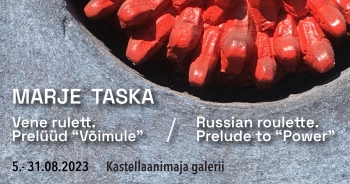Visiting artist Britta Marakatt-Labba; curator Reet Varblane; designer Ulla Juske; graphic designer Villu Plink; art technician Reinhold Rutks.
Marje Taska (b. 1955) has been active as an artist and curator for the last three decades both in Estonia and in Sweden. Her solo exhibition "Mother_land" ran in the Barrel Gallery of Viinistu Art Museum in June and her early graphic art can currently be seen at the group exhibition of women graphic artists "Through the Black Gorge of Your Eyes" in Kumu.
The Castellan House exhibition "Russian Roulette" engages with the topic of power. Power is an attribute of self-establishment, a premise of ruling over somebody or something. Power is a relationship with somebody or something. Any structure needs this in order to function, but it is also dangerous, tempting, seductive, terrible and frightening, suppressive, controlling. Marje Taska is less interested in the public manifestation of power than in its undercurrents, its modus operandi that remains out of reach and beyond comprehension for the members of society. In her own words: "We're living in a treacherous time when our existence as a social group is in question. Many of us have no energy to read the news or don't trust it. The corridors of power are long and secretive. Who are the actual decision makers? What's going on around us and our planet? Do we know the whole truth?"
The work "Russian Roulette", composed of two objects, a red and a black relief, serves as an introduction to the Castellan House exhibition. Russian roulette, the game that common sense perceives as a pointless endangering of life can be viewed as behaviour on the verge of absurdity, a self-destructive urge, an aversion to everyday routine and orderliness, as well as resistance to the highest power (human life that manifests as God as the highest principle or natural sanctity) and a tempting of fate. The topic of memory has always been important for Marje Taska: in the context of the topic of power she views the struggle for power as a struggle with memory. Either direct or metaphoric relationships between memory and power can be identified in the series of reliefs, regressing in scale: in the installation about earth in the series "Mother_land" (2001) and in several paintings on wood in the series "Participation Mystique" (2021-2023).
The subtitle of "Russian Roulette", " Prelude to "The Power"", refers to "The Power", the last part of the trilogy "A Baton from Kütiorg to Kadriorg", which was supposed to be displayed in Kadriorg Park, Kadriorg Art Museum and the Castellan House in August, but it had to be postponed and will be opened in Kadriorg Park and the art museum on September, 8. The project of the curators Marje Taska and Reet Varblane started two years ago in Võru – the exhibition "The Force" at Vana-Võromaa Museum and Art Gallery, next spring in Tartu – the exhibition "The Spirit" in the University of Tartu Museum and St. John's Church and the final show in Kadriorg Park in Tallinn. The visiting artist of "Russian Roulette" is the Swedish Saami artist Britta Marakatt-Labba (1951) who Marje Taska had wanted to pass the "baton" over to already in "The Force" in Võru. Understandably, aboriginal nations and neocolonialism are trending topics in contemporary art. The stitched narratives of Marakatt-Labba, Saami life, activism, the synthesis of history and mythology are increasingly attracting the attention of big biennales and museums and the artist was unable to join her old colleague in Võru. In the Castellaan House exhibition Marakatt-Labba displays her serigraphies based on her stitched stories. Next to Britta Marakatt-Labba's serigraphies is Marje Taska's hommage to her colleague and the Saami people: a synthesis of reality and mythology painted on wood in the work "Sápmi" (a Saami inhabited territory stretching from Norway to Russia).
Reet Varblane
Thanks to Kadrioru Park OÜ, Edvin Nugis, Hille Karm, Andri Ksenofontov ja Miriam McIlfatrick-Ksenofontov.
